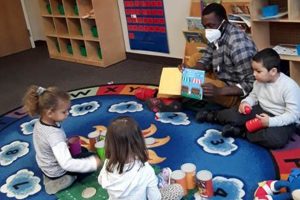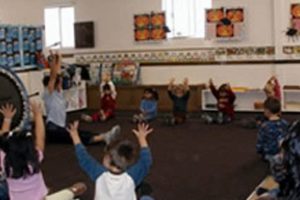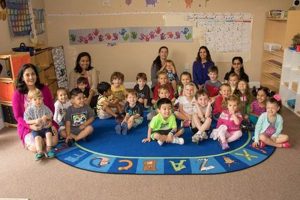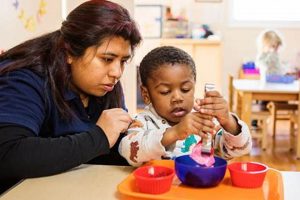Traditional preschools and Montessori programs represent distinct approaches to early childhood education. Preschools typically follow a structured curriculum with teacher-directed activities, focusing on social-emotional development and preparing children for kindergarten. Montessori education, on the other hand, emphasizes self-directed learning, hands-on exploration, and mixed-age classrooms. Children choose their activities from a range of specially designed materials that encourage independent discovery and mastery of concepts at their own pace.
The contrasting philosophies impact the learning environment and child development. While a structured preschool setting offers predictability and group interaction, a Montessori environment fosters independence, self-reliance, and a deeper understanding of concepts through direct experience. The origins of these differences can be traced back to the distinct educational theories of their founders, reflecting differing views on child development and the role of the educator.
This article will further examine the nuances of each approach, exploring the specific benefits and drawbacks of traditional preschool and Montessori education to aid parents in making informed decisions about their child’s early learning journey. Key areas of comparison will include curriculum structure, teaching methodology, assessment practices, and the overall learning environment.
Tips for Choosing Between Preschool and Montessori
Selecting the right early childhood education program is a crucial decision. These tips offer guidance for navigating the preschool and Montessori landscape.
Tip 1: Observe the Classroom Environment: Visiting potential schools provides invaluable insight. Note the atmosphere, materials available, and interactions between children and teachers. A Montessori classroom will feature distinct learning areas with specialized materials, while a preschool classroom may be organized around themes or learning centers.
Tip 2: Consider the Child’s Learning Style: Some children thrive in structured environments with clear expectations, while others flourish with greater autonomy. Reflect on the child’s personality, interests, and preferred learning methods.
Tip 3: Evaluate Curriculum and Teaching Philosophy: Examine the curriculum’s scope and sequence. Montessori emphasizes self-directed learning with a focus on practical life skills, sensorial exploration, and academic concepts. Preschool curricula often incorporate play-based learning with structured activities.
Tip 4: Assess Teacher Qualifications and Experience: Inquire about teacher training and experience in early childhood education. Montessori teachers undergo specialized training in the Montessori method. Preschool teachers typically hold certifications in early childhood education.
Tip 5: Explore Program Costs and Schedules: Understand the program’s tuition fees, schedule options, and any additional costs associated with materials or extracurricular activities.
Tip 6: Engage with Current Parents and Students: Speaking with families enrolled in the programs can provide valuable perspectives on the school’s community, culture, and overall effectiveness.
Tip 7: Consider Long-Term Educational Goals: Reflect on the desired educational path for the child. While both approaches prepare children for kindergarten, they instill different learning styles and values that may influence future educational choices.
By carefully considering these factors, parents can make an informed decision that aligns with their child’s individual needs and developmental trajectory. Choosing the right early learning environment lays a strong foundation for future academic and personal success.
Ultimately, the optimal choice depends on the individual child and family. This article will conclude with a summary of key differences and considerations to aid in this important decision-making process.
1. Learning Approach
A fundamental distinction between preschool and Montessori lies in their respective learning approaches. This core difference shapes the classroom environment, curriculum design, and the teacher’s role. Understanding these contrasting approaches is critical for parents evaluating early childhood education options.
- Child-Directed vs. Teacher-Directed Learning
Montessori classrooms prioritize child-directed learning, where children choose their activities and pace. This self-directed exploration fosters independence and intrinsic motivation. Conversely, traditional preschools typically employ a teacher-directed approach, with structured lessons and group activities. This provides a predictable learning environment and focuses on specific skills development.
- Hands-on Exploration vs. Conceptual Learning
Montessori emphasizes hands-on learning through specially designed materials that engage multiple senses. Children manipulate concrete objects to internalize abstract concepts. Preschools may also incorporate hands-on activities, but often prioritize conceptual learning through direct instruction and symbolic representation.
- Individualized Pace vs. Standardized Curriculum
Montessori education recognizes that children learn at different rates. The individualized curriculum allows children to progress through concepts at their own speed, fostering mastery and preventing frustration. Preschools generally follow a standardized curriculum with set milestones for all children, emphasizing group progress and social-emotional development.
- Mixed-Age Classrooms vs. Age-Segregated Groups
Montessori classrooms typically group children of different ages (e.g., 3-6 years old). This fosters peer learning, where younger children observe and learn from older peers, while older children reinforce their understanding through mentorship. Preschools typically separate children into age-based cohorts, facilitating targeted instruction and age-appropriate social interaction.
These differing learning approaches reflect distinct educational philosophies and impact the overall learning experience. While both aim to prepare children for future academic success, the chosen approach significantly influences the development of learning styles, social skills, and self-reliance.
2. Teacher's Role
The teacher’s role represents a pivotal distinction between preschool and Montessori settings. This difference stems from the contrasting educational philosophies underlying each approach. In a traditional preschool, the teacher typically acts as the primary instructor, leading activities, directing learning, and managing the classroom. This approach emphasizes direct instruction, where the teacher disseminates knowledge and guides children through a predetermined curriculum. For instance, a preschool teacher might lead a circle time activity focused on letter recognition, guiding the children through songs and flashcards. This teacher-centered approach provides structure and ensures consistent delivery of the curriculum.
In contrast, a Montessori teacher serves as a guide and facilitator, observing children, preparing the environment, and intervening strategically to support individual learning journeys. Rather than directing learning, the Montessori teacher creates opportunities for children to explore, discover, and learn independently. For example, a Montessori teacher might introduce a child to a specific material, demonstrating its proper use and then allowing the child to explore its functionalities independently. This child-centered approach fosters self-reliance, problem-solving skills, and a deeper understanding of concepts through direct experience. The Montessori teacher’s role emphasizes observation and individualized guidance, tailoring interventions to each child’s unique needs and developmental stage.
Understanding this fundamental difference in the teacher’s role is crucial for parents selecting an early childhood education program. The level of direct instruction versus facilitated exploration directly impacts a child’s learning style, independence, and overall development. While both approaches offer valuable learning experiences, the preferred teacher’s role should align with the child’s personality, learning preferences, and the family’s educational goals. This distinction underscores the importance of observing classroom dynamics and engaging with teachers to understand their pedagogical approach before making an informed decision.
3. Curriculum Structure
Curriculum structure represents a significant point of divergence between preschool and Montessori education. Preschools typically adhere to a predetermined, often standardized, curriculum with defined learning objectives for each age group. This structured approach emphasizes sequential skill development, often focusing on literacy, numeracy, and social-emotional skills deemed essential for kindergarten readiness. A typical preschool curriculum might involve thematic units, scheduled learning centers, and whole-group instruction. For example, a unit on the seasons might include activities like crafting autumn leaves, singing songs about winter, and learning about the life cycle of plants in spring. This structured approach provides a clear roadmap for learning and allows teachers to assess progress against established benchmarks.
Montessori curriculum, conversely, offers a prepared environment with a wide range of self-directed learning materials organized into distinct areas: Practical Life, Sensorial, Mathematics, Language, and Culture. Children choose activities that pique their interest, fostering intrinsic motivation and self-paced learning. This approach encourages exploration and deeper understanding through repetition and self-discovery. For instance, a child might choose to work with the pink tower in the Sensorial area, developing visual discrimination and fine motor skills, or select letter tiles in the Language area to practice spelling. The Montessori curriculum, while encompassing similar fundamental concepts, prioritizes self-directed exploration and individualized learning paths rather than a prescribed sequence.
The contrasting curriculum structures reflect differing educational philosophies and have practical implications for children’s learning experiences. A structured preschool curriculum offers predictability and consistent exposure to key concepts, while the Montessori approach cultivates self-reliance, independent thinking, and a deeper engagement with learning materials. Understanding these differences empowers parents to select an educational environment aligned with their child’s individual learning style and developmental needs. The choice hinges on whether a structured, teacher-directed approach or a self-directed, exploratory environment best suits the child’s personality and learning preferences.
4. Learning Materials
Learning materials represent a tangible manifestation of the philosophical differences between preschool and Montessori education. In preschool settings, materials often consist of commercially produced toys, games, art supplies, and books selected to support thematic units or learning centers. These materials typically serve multiple purposes and are adaptable to various activities. For example, building blocks might be used for constructing towers one day and for sorting by color the next. This flexibility allows preschool teachers to guide learning towards specific curriculum objectives while accommodating diverse learning styles. The emphasis tends to be on versatility and engagement rather than specialized pedagogical design.
Montessori classrooms, in contrast, feature meticulously crafted, self-correcting materials designed to isolate specific concepts and skills. These materials, often made of natural wood, are aesthetically appealing and invite hands-on exploration. The Montessori pink tower, for instance, consists of ten graduated wooden cubes, enabling children to internalize concepts of size, dimension, and sequential order. Similarly, the sandpaper letters introduce phonics through tactile exploration. These specialized materials are central to the Montessori method, encouraging self-directed learning, problem-solving, and a deeper understanding through concrete experience. Each material has a defined purpose, promoting focused engagement and mastery of specific skills.
This divergence in learning materials reflects the contrasting pedagogical approaches of preschool and Montessori education. While preschool materials prioritize flexibility and adaptability to support a teacher-directed curriculum, Montessori materials are intentionally designed to facilitate self-discovery and independent learning. Understanding this distinction highlights the emphasis placed on individualized learning within the Montessori method and the importance of structured activities within a traditional preschool setting. Choosing between these approaches often depends on a family’s educational philosophy and the child’s individual learning style. The nature of the learning materials provides a concrete and readily observable indication of the overall learning experience offered by each approach.
5. Social Environment
The social environment constitutes a key differentiator between preschool and Montessori classrooms. This distinction stems from the pedagogical approaches and underlying philosophies of each educational model. The social dynamics within the classroom significantly impact children’s development of social skills, cooperation, independence, and overall learning experience. Examining the social structures of each setting provides valuable insight for parents considering early childhood education options.
- Age Grouping
Preschools typically employ age-segregated classrooms, grouping children of the same age together. This structure facilitates targeted instruction and activities tailored to specific developmental stages. For example, a preschool class of four-year-olds might engage in activities focused on pre-reading skills and cooperative play suitable for their age group. Montessori classrooms, conversely, often feature mixed-age groupings, typically spanning three-year age ranges (e.g., 3-6 years old). This mixed-age environment fosters peer learning, mentorship, and a sense of community. Younger children observe and learn from older peers, while older children reinforce their understanding by guiding and assisting younger ones. This dynamic creates a natural social hierarchy and promotes a more nuanced understanding of social interactions.
- Interaction Dynamics
Preschools often emphasize group activities and teacher-directed interactions, fostering collaboration and shared learning experiences. Circle time, group projects, and structured playdates are common features. This approach encourages social interaction and the development of communication skills within a structured setting. Montessori classrooms, while also valuing social interaction, prioritize individual work and self-directed exploration. Children are free to choose their activities and work independently or in small groups. This approach fosters concentration, self-reliance, and the development of intrinsic motivation. Social interaction occurs organically as children choose to collaborate or observe one another’s work.
- Conflict Resolution
In preschool settings, teachers often intervene directly in conflict resolution, guiding children through problem-solving strategies and enforcing classroom rules. This structured approach provides a framework for managing disagreements and promotes social harmony. Montessori classrooms encourage children to resolve conflicts independently, fostering self-advocacy and problem-solving skills. Teachers act as facilitators, guiding children through the process but empowering them to find solutions themselves. This approach develops negotiation skills and encourages children to take ownership of their social interactions.
- Independence and Collaboration
Preschools typically balance independent activities with structured group projects, promoting both individual development and collaborative skills. This approach prepares children for the varied learning environments they will encounter in kindergarten and beyond. Montessori classrooms place a strong emphasis on individual work and self-directed learning, fostering independence and self-reliance. While collaboration occurs naturally, it is not a primary focus. This approach cultivates a sense of personal responsibility and the ability to pursue learning goals independently.
These differences in social environment reflect the distinct educational philosophies underpinning preschool and Montessori education. The choice between these environments should align with a family’s values and the child’s individual personality and learning style. Understanding the social dynamics of each approach empowers parents to select the setting that best supports their child’s social-emotional development and overall learning journey.
Frequently Asked Questions
This section addresses common inquiries regarding the distinctions between preschool and Montessori education. Clarity on these points assists families in selecting the most suitable early childhood program.
Question 1: Which approach better prepares children for kindergarten?
Both preschool and Montessori programs aim to equip children with the skills and knowledge necessary for kindergarten. Preschools often focus directly on pre-academic skills and social-emotional development typically emphasized in kindergarten curricula. Montessori programs, while not explicitly focused on kindergarten readiness, cultivate independence, problem-solving skills, and a love of learning, which contribute significantly to later academic success. The best approach depends on the individual child’s learning style and the specific kindergarten program.
Question 2: Is one approach more academically rigorous than the other?
Academic rigor manifests differently in preschool and Montessori settings. Preschools often follow a structured curriculum with defined academic goals, potentially leading to earlier exposure to formal academic concepts. Montessori emphasizes self-paced mastery, allowing children to delve deeper into subjects of interest and potentially achieving a more profound understanding. Both approaches can be academically stimulating, but their methods and focus differ.
Question 3: Which approach is better for children with special needs?
Both preschool and Montessori environments can accommodate children with special needs, but the suitability depends on the individual child’s specific needs and the program’s resources. Montessori’s individualized learning plans and adaptable environment can be beneficial for some children with special needs. However, a preschool’s structured setting and focus on specific skill development might be more appropriate for others. Consultation with specialists and careful observation of potential programs are essential for informed decision-making.
Question 4: Is Montessori education only for gifted children?
Montessori education is designed for all children, not just those identified as gifted. Its emphasis on self-directed learning and individualized pacing caters to diverse learning styles and abilities. While gifted children may thrive in a Montessori environment, the approach is equally beneficial for children with varying learning profiles.
Question 5: Are Montessori programs more expensive than preschools?
The cost of Montessori programs and preschools varies widely depending on location, program duration, and specific school offerings. Generally, Montessori programs tend to be comparable in cost to private preschools, but less expensive than some specialized or full-day programs. Publicly funded Montessori programs are also available in some areas.
Question 6: Can a child transition smoothly from a Montessori preschool to a traditional elementary school?
Children successfully transition from Montessori preschools to various elementary school settings, both traditional and alternative. The skills fostered in Montessori environments, such as independence, self-regulation, and a love of learning, often contribute positively to their adaptation to new academic settings. While the structured environment of a traditional elementary school might differ from the Montessori approach, children generally adapt readily.
Choosing the right early childhood education program requires careful consideration of individual needs, family values, and educational philosophies. This FAQ section provides a starting point for further exploration and informed decision-making.
This concludes the comparative analysis of preschool and Montessori education. The subsequent section offers a summary of key takeaways and considerations for parents.
Conclusion
The difference between preschool and Montessori education encompasses a range of pedagogical and philosophical distinctions. This exploration highlighted key variations in learning approaches, teacher roles, curriculum structures, learning materials, and social environments. Preschools typically offer structured, teacher-directed learning within age-segregated classrooms, utilizing versatile materials to support a predetermined curriculum. Montessori programs, conversely, emphasize self-directed learning within mixed-age environments, employing specialized materials to foster exploration and individualized learning journeys. The teacher’s role shifts from instructor to guide, empowering children to pursue their innate curiosity and develop self-reliance.
Selecting the optimal early childhood education environment requires careful consideration of a child’s individual learning style, developmental needs, and family values. Understanding the nuanced differences between preschool and Montessori education empowers informed decision-making, laying a solid foundation for a child’s lifelong learning journey. This comparative analysis serves as a starting point for further investigation and encourages families to visit prospective programs, engage with educators, and reflect on their own educational priorities. The ultimate goal is to create a nurturing and stimulating learning environment that fosters a child’s intellectual, social, and emotional growth.







